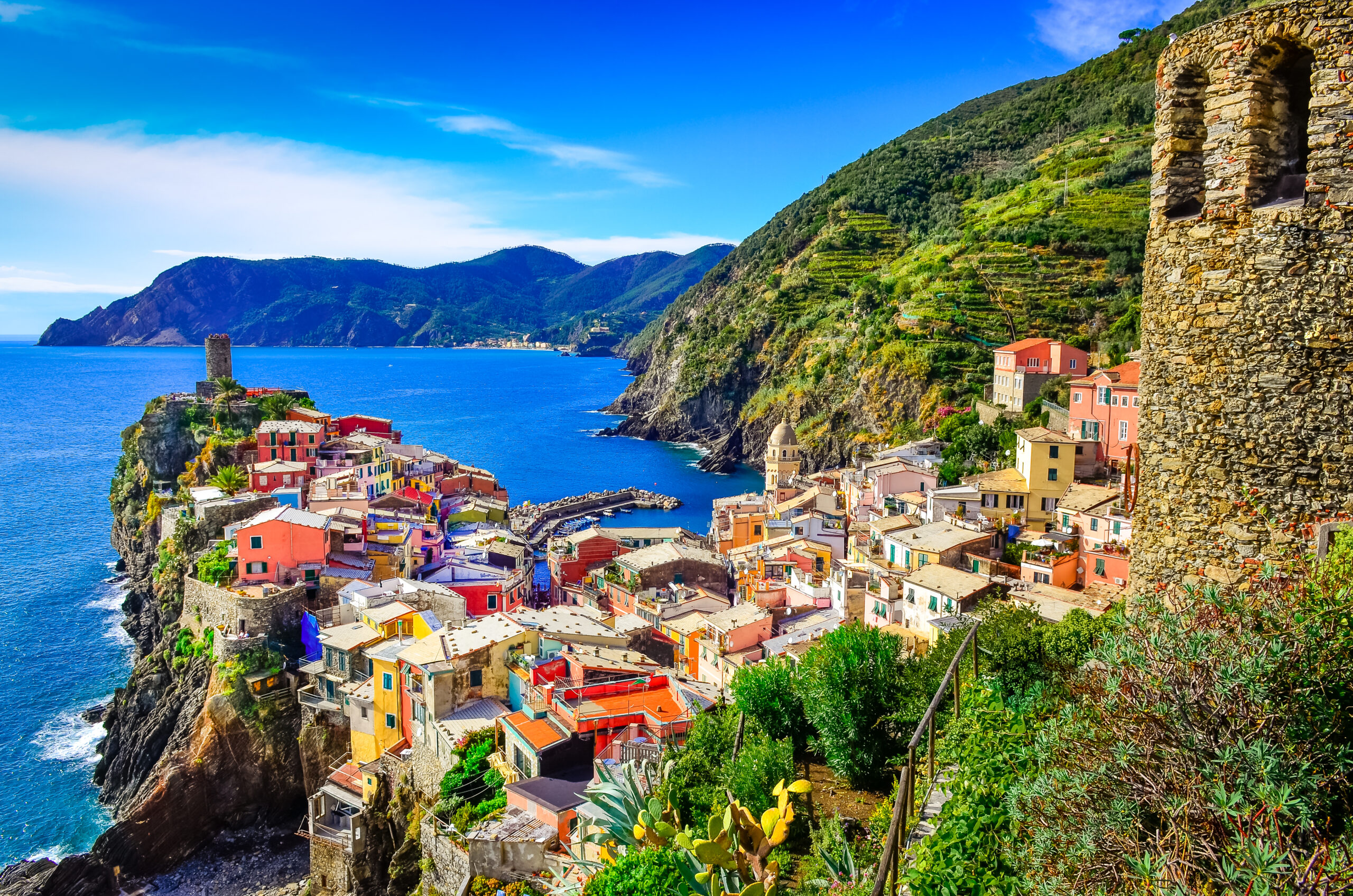Liguria is the third smallest province in Italy. It is actually just a narrow coastal strip from the Cote d’Azur to Tuscany, where the Mediterranean is directly followed by the mountains. Simply ” sea and mountains”. To the east is the Riviera di Levante, to the west the Riviera di Ponente and in the middle the capital Genoa. The sea and high mountains, the Ligurian Maritime Alps, are found in the smallest of spaces.
This location makes Liguria unique. Everything is possible, from sunbathing to extreme sports. The Association of Friends of Outdoor Sports in Liguria is dedicated to hang gliding and paragliding. Free climbers will find more than 1,500 climbing routes near Finale Ligure alone, while white water rafting is also on offer alongside diving, kitesurfing, surfing and SUP. Hiking and cycling are less adrenaline-pumping.
Liguria also scores with art and culture. Genoa in particular has, and always has had, important art collections to offer. And all this all year round. Although “the season” begins in March, the mild climate makes the Ligurian coast a real year-round destination.
San Remo
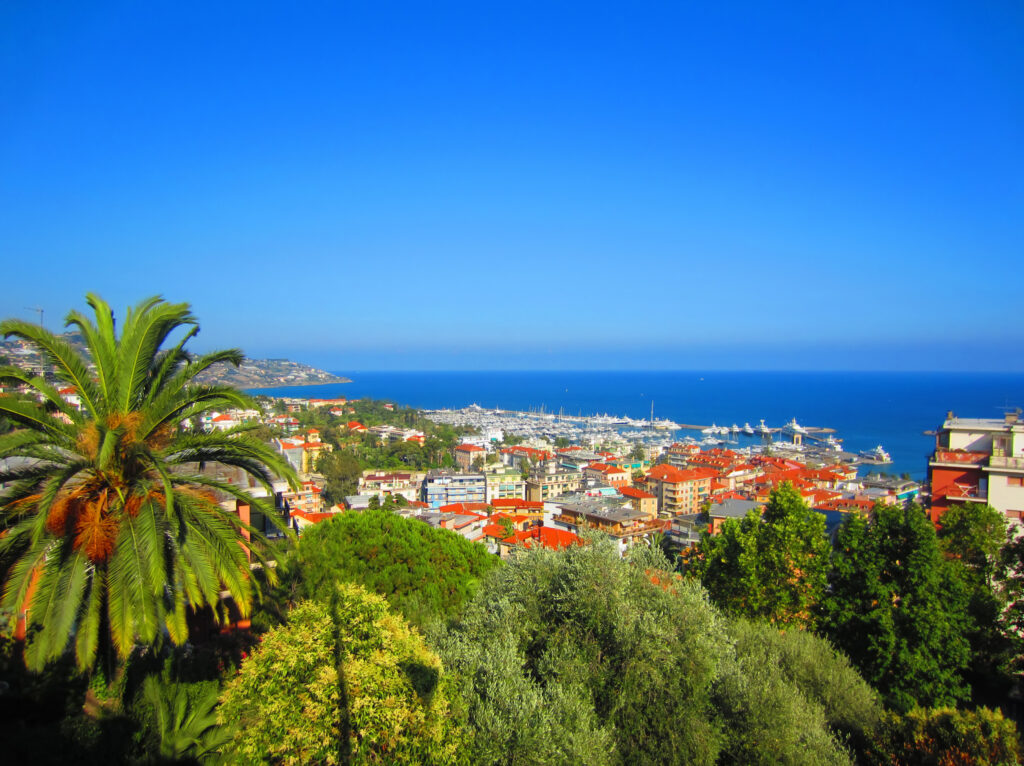
Those who book their vacation in San Remo, Italy, need not worry about a varied cultural and leisure offer. The picturesque port city with its almost 57,000 inhabitants on the Ligurian coast not only has a world-famous casino, but culture and music are also very important here. At the same time, San Remo’s oriental-style old town and the city’s wonderfully fragrant flower fields invite visitors to take romantic walks. The year-round mild climate perfectly rounds off a relaxing vacation.
Already the famous inventor and name giver of the probably most desired science price Alfred Nobel had succumbed to the enchanting charm of San Remo at the end of the 19th century, when he settled there in 1891. Since 2002, his stately villa in neo-Gothic style with clearly recognizable colonial as well as oriental influences has been open to the public.
By far the most famous building in San Remo is the city’s casino. Built in 1905 in the Liberty style, it was the only casino in Italy during the Mussolini era that did not have to close. The magnificent building has seen many a famous visitor, including Duke Ellington, for example. Evening wear is definitely recommended when visiting the elegant casino. On the other hand, the city park of San Remo is more casual. Here you can discover the lush splendor of tropical plants in an unprecedented variety of colors.
Rapallo
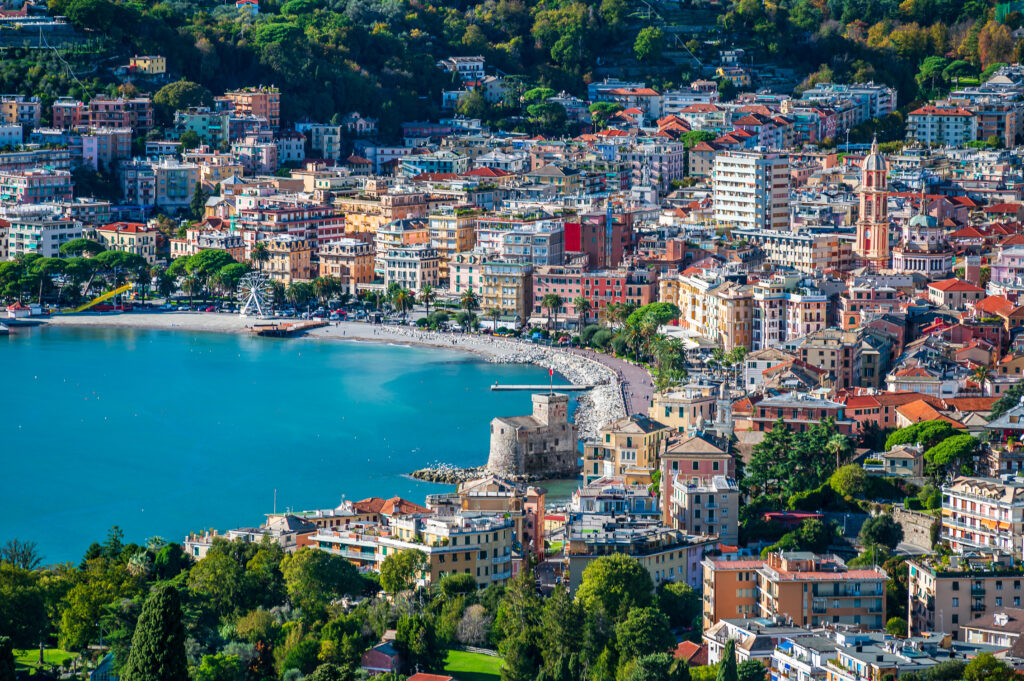
Today, Rapallo is first and foremost a charming seaside resort on the Ligurian Mediterranean coast. Located not far from Genoa, the town of around 30,000 inhabitants is one of the larger vacation resorts on the Riviera di Levante.
In enchanting Rapallo, vacationers will find almost everything that makes a tourist’s heart beat faster. An attractive range of leisure activities with many water sports options and an 18-hole golf course, excellent cuisine with fresh seafood and a past steeped in history that has left behind many sights.
The 16th century harbor castle towers almost like a landmark on the edge of Rapallo’s picturesque marina. The harbor can accommodate up to 400 yachts. However, most of the sights are located around the central meeting point of the old town, Piazza Cavour. Here you can discover, among other things, a magnificent parish church with a bell tower dating back to 1857. To see the art of Ligurian lace-making, however, you must visit the “Museo del Pizzo al Tombolo”. There are over 1,400 outstanding pieces of bobbin lace here.
When in Rapallo, don’t miss out on a visit to one of the romantic restaurants around the harbor, which primarily impress with their healthy and varied fish cuisine. One of the region’s dry white wines is an excellent accompaniment. Lasagne al pesto and focaccia all’olio are also typical of Rapallo.
Genoa
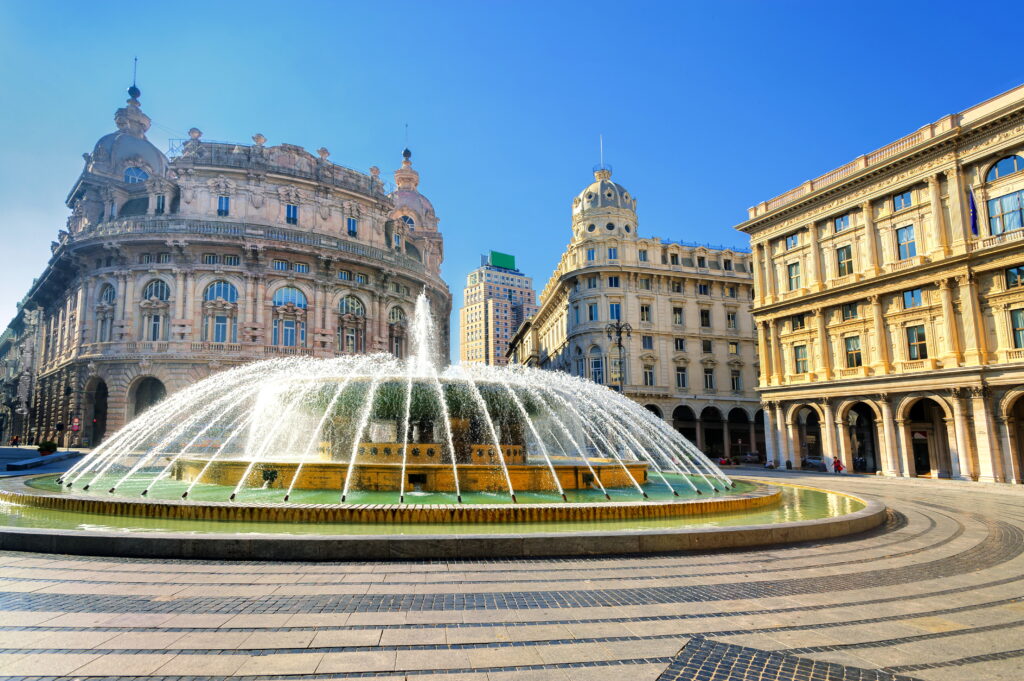
The major Italian city of Genoa is the capital of the Liguria region and has about 800,000 inhabitants. Due to the numerous historical sights throughout the city and the many cultural institutions, the city is one of the most popular destinations in Italy. The picturesque old town of Genoa is the largest in Europe and impresses with its imposing buildings.
Among the most impressive attractions are the boulevards Le Strade Nouve with the Palazzi dei Rolli, which have been declared a UNESCO World Heritage Site. Also worth seeing is the city’s old harbor, where visitors will find many small cafes and inviting restaurants to linger in comfort.
The Genoa Lighthouse is located on the San Benigno hill high above the city. Due to its elevated position, it can be easily seen from any direction and should definitely be visited during a stay. With its height of 77 meters, the tower is the highest European lighthouse and has two large viewing platforms. Visitors have a fantastic view of the old town and the port of Genoa from here.
In addition, the city attracts many international guests with its medieval castles and fortresses, for example, the Castello Mackenzie and the famous Forte Sperone.
Portofino
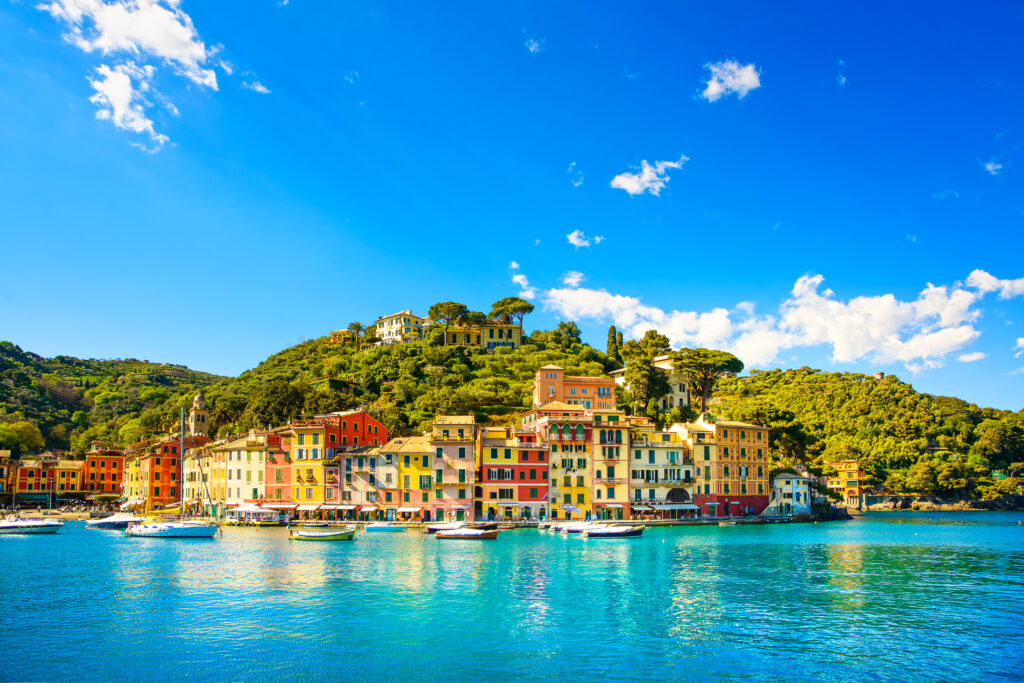
In Portofino, vacationers can unwind away from the hustle and bustle of large resorts. The bay of Portofino resembles a postcard motif, and the beautiful harbor is just as inviting for relaxing walks as the narrow streets of the old town.
Unlike in many Italian tourist resorts, visitors to Portofino experience the Italian way of life in its most original form. The Dolce Vita is written very large here, and so the idyllic fishing village invites you to a relaxing vacation. The harbor and the many small bays of the village are particularly popular with guests.
The town in the Italian province of Liguria has numerous historical sights, including the church of San Giorgio and Castello Brown. Between Mediterranean forests and olive groves, many celebrities have discovered the peace and seclusion of the fishing village of Portofino for themselves and thus built their luxurious villas there.
The beaches of the small harbor town are perfect for spending a relaxing day by the sea. The water in the many small bays is incredibly clear and shimmers in countless colors. Here, vacationers can enjoy a carefree tranquility and leave the stressful everyday life behind.
A walk or a longer hike through the woods around Portofino are as relaxing as they are exciting, because there is always something to discover in the Mediterranean landscape. When visiting the harbor in the evening, there is a good chance of spotting a celebrity or two on their yacht.
Cervo
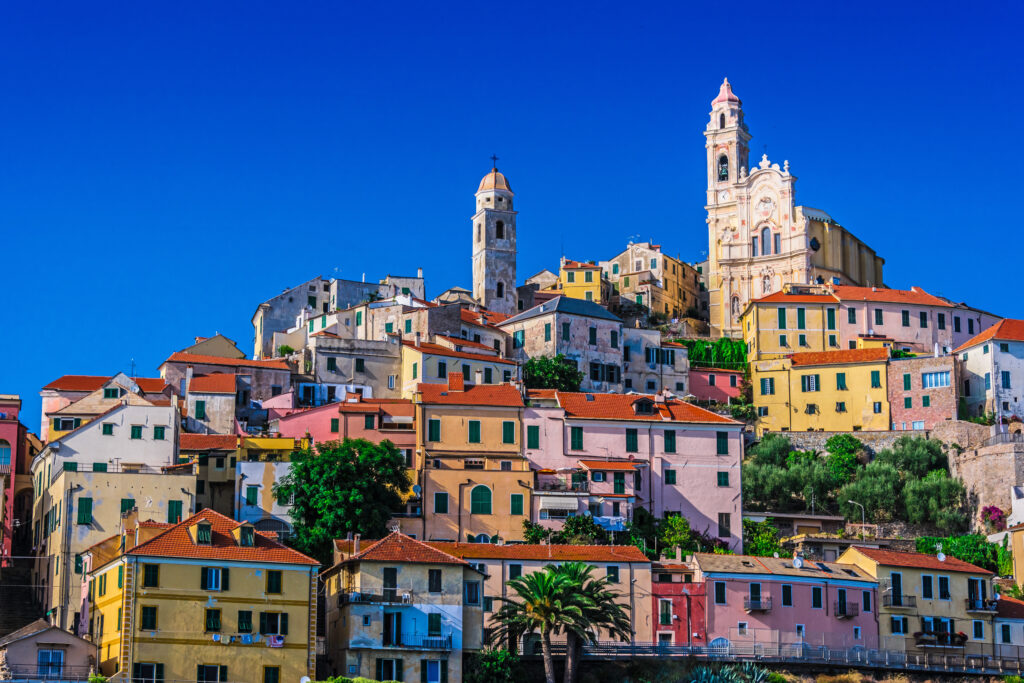
Music lovers know Cervo in the Ligurian province of Imperia mainly for the internationally renowned festival of chamber music held here. But visitors are also drawn here by its historical significance and unique beauty.
The name Cervo (deer) derived from the Roman goddess of hunting, Diana. The town is located just a few kilometers from the popular seaside resort of Alassio. And yet the clocks here go differently: swimming is only possible on a small pebble beach outside the town, and Cervo’s narrow streets are car-free. Only the odd Ape, the three-wheeled scooter from Piaggio, rattles leisurely through the streets here and there.
Steep paths lead up to the medieval old town and the fortress Castello di Cervo, also called Castello dei Clavesana. This was once the residence of the Counts of Clavesana. Today, parts of the complex serve as a town museum.
High above the town towers the church of San Giovanni Battista, also called the Church of the Coral Fishermen. Once donated by the “Corallini”, the early 18th century church enchants with its magnificent Baroque façade and a sweeping flight of steps against the backdrop of the sea.
La Spezia
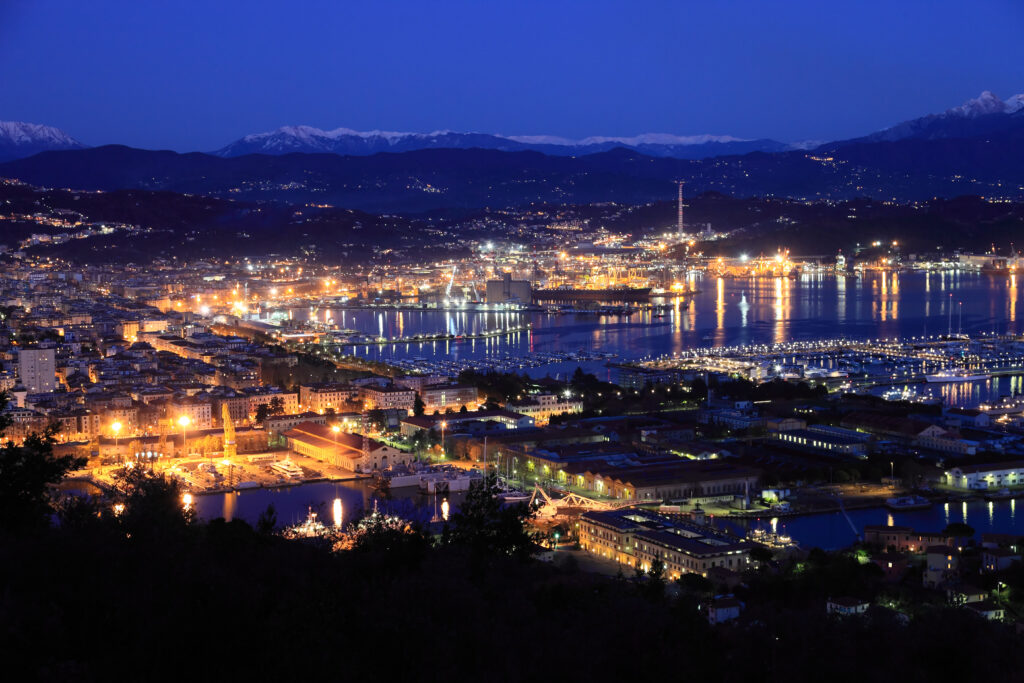
La Spezia, with just over 95,000 inhabitants, is a medium-sized city on the Ligurian coast not far from Genoa. It lies protected in the natural Golfo dei Poeti, the “Gulf of the Poets”.
Almost all of La Spezia’s sights are located near the city center, making them all within easy walking distance for visitors. Above the old town lies the Castello San Giorgio. The foundation walls of the former fortress date back to the 12th century, and from the old battlements there is a very nice view of the city. A visit to the church of Santa Maria Assunta is also recommended.
Originally it dates back to the 13th century, but over the centuries it was destroyed twice. Today you can also find wonderful paintings from different periods. A good example of neoclassical architecture, on the other hand, is the Palazzo delle Poste in the middle of Via Vittorio Veneto in La Spezia, which today houses the main post office.
As a visitor to La Spezia, you should not miss tasting the wine Sciachetrà, grown in the surrounding vineyards and considered a specialty by connoisseurs. The Romans already knew how to appreciate this grape juice, which is already mentioned in ancient writings.
Portovenere
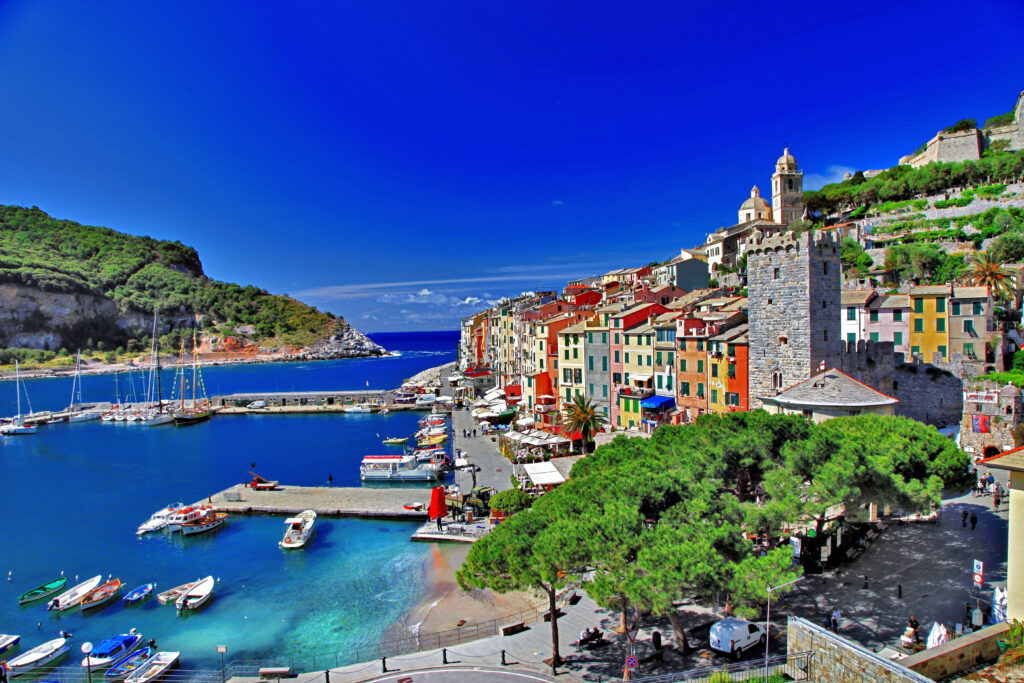
The first thing you see of Portovenere is a tower with an extension, similar to a lighthouse, perched high on the tip of a promontory. Although there is a towering fortress wall below the building, the castle-like structure is just a church – the Church of St. Pietro.
Once you reach the fishing port of Portovenere, a long row of facades of different colors unfolds before you, running along the coast and its harbor. The facades belong to the houses of Portovenere, which resemble several colored five-story cubes and give the place its unique colorful look. The place got its name from the Romans, who called it Veneris Portus – Port of Venus. And the Romans knew why they named this place after the goddess of beauty and love.
The small harbor town exudes its own charm. Right at the harbor, restaurants and bars invite you to an entertaining Italian dinner. Especially in summer, when the lukewarm breeze blows in from the sea in the evening, the red wine of the region is best enjoyed. The lively hustle and bustle at the harbor and on the harbor promenade provides variety just by watching.
Above the harbor on the hilltop rises the Doria Castle, named after the builders: the Doria family. From the terraces of the castle you can enjoy the view of the small port town that stretches below the castle.
Ventimiglia
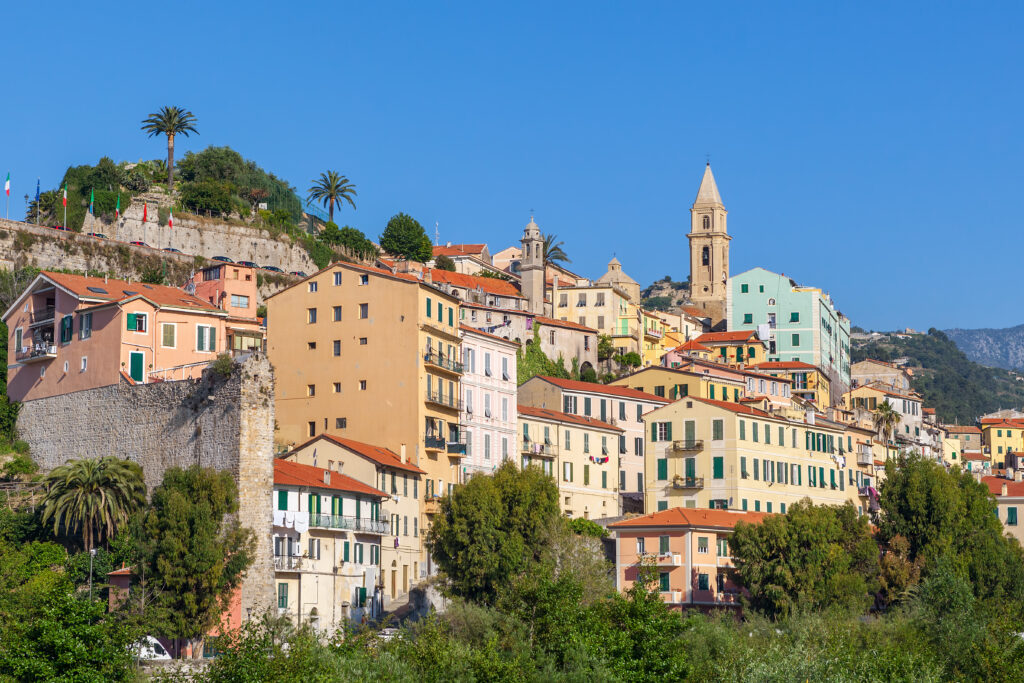
The city of Ventimiglia attracts as a seaside resort and health resort on the Italian Riviera, but also with its proximity to the French Côte d’Azur. Guests from all over the world travel to this southernmost region of the province of Imperia to enjoy equally the seclusion of Liguria and the flair of its beach metropolises. During a trip you can explore famous caves in the mountains, go on long hikes or bike rides and at the same time discover wonderful beaches, relax and get away from everyday things.
The city of Ventimiglia is located in the Ligurian province of Imperia and on the Riviera di Ponente, the western part of the Italian Riviera. Already in Roman times it was famous for the thermal baths of Augustus, and still today it is a spa and seaside resort.
Worth seeing are especially the wonderful old town with the Cathedral of Santa Maria Assunta and the church of San Michele from the 10th century, under which there is a pre-Romanesque hall crypt. Also very interesting is the 16th century Piedmont Gate on the road to the Tenda Pass, the link between Liguria and Piedmont.
Noli
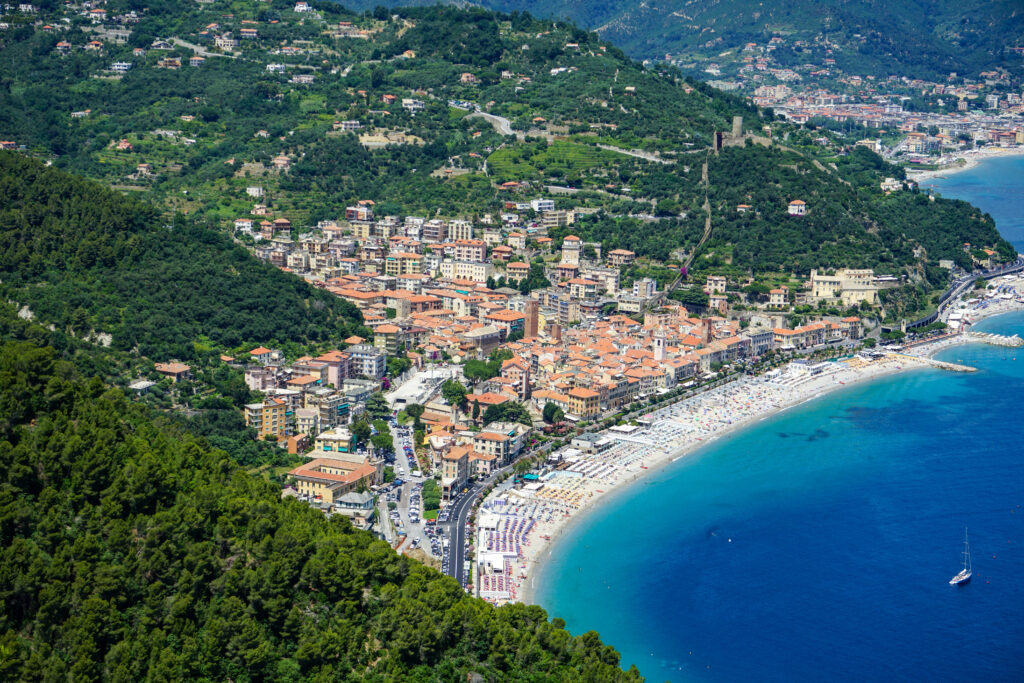
The small village of Noli is located directly in a bay that extends to the west to Capo Noli. From here you can enjoy a great view over the breathtakingly beautiful landscape. The municipality, formerly also called Neapolis, is one of the “Borghi più belli d’Italia”, the most beautiful villages in Italy. During the Middle Ages Noli had a great economic and historical importance. Today you can still walk in the footsteps of history in the well-preserved, charming village center.
Until the 15th century there were numerous wars of conquest by the Saracens, and even today many place names recall this period. Another relic of this period are the oldest parts of the fortress of Noli, which today are among the most important cultural monuments of the region. From the fortification of the Middle Ages, some towers and city gates can still be seen. Among them, the 38-meter high Torre dei quattro canti, the Torre del Comune, the Torre Peluffo and the Torre Papone.
The church of S. Paragorio, dating back to the 11th century, was once built in Romanesque style and later partially remodeled in Renaissance style. Also worth seeing are the ruins of the 12th century Castello di Monte Ursino and the Loggia della Republica.
Around Noli you don’t have to fear mass tourism yet. In the bay of Noli there is an attractive sandy and pebble beach lined with palm trees.
Santa Margherita
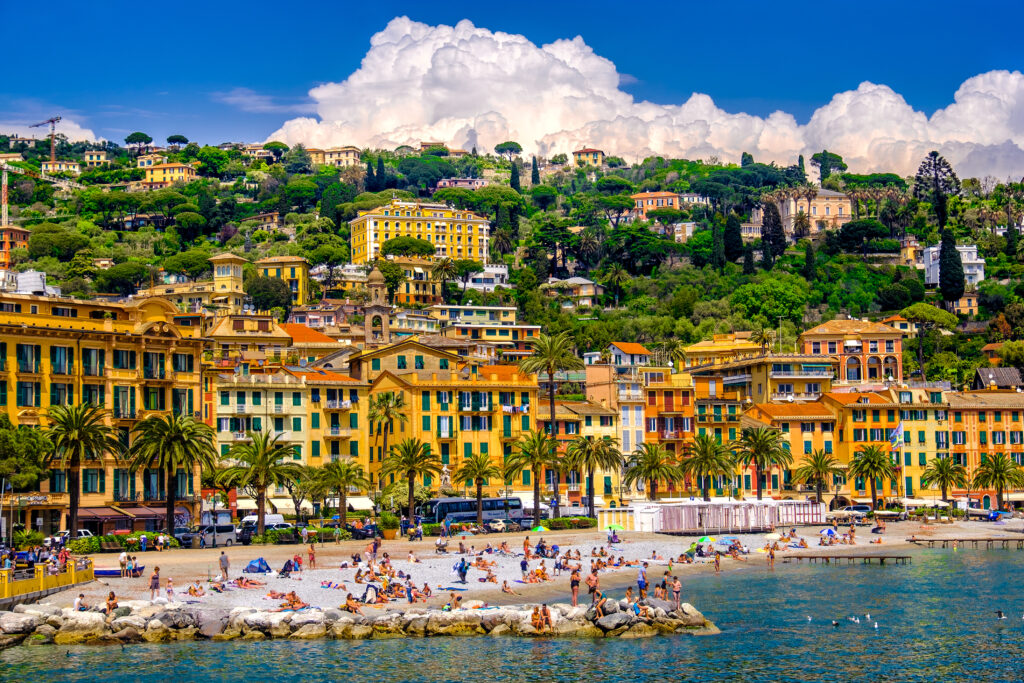
Santa Margherita Ligure is located about 35 kilometers from Genoa, between the cities of Portofino and Rapallo. This town in the Liguria region attracts tourists who prefer an elegant ambience on vacation. As accommodation there are numerous luxury class hotels as well as magnificent old villas. Travelers from all over the world prefer to stroll along the lively harbor promenade and enjoy Italian specialties in the restaurants and cafes.
Santa Margherita Ligure is also known as the Pearl of Tigullio and developed into an exclusive vacation destination after the Second World War. The charm of the village is, among other things, the first-class hotels, the proximity to the city of Portofino and the many seaside resorts.
The center of the Italian community is the harbor with its beautiful promenade. This serves not only as an anchorage for fishing boats and yachts, but also as a starting point for various cruises. In addition, international regattas, other water sports events and cultural events are held here regularly.
The exclusive stores and art galleries invite you to stroll through the lively city center. Santa Margherita Ligure was extremely popular with film directors in the 60s, 70s and 80s and served frequently as a film set. Those who choose a beach vacation will find many beautiful beaches and secluded bays for extensive sunbathing.
Lerici
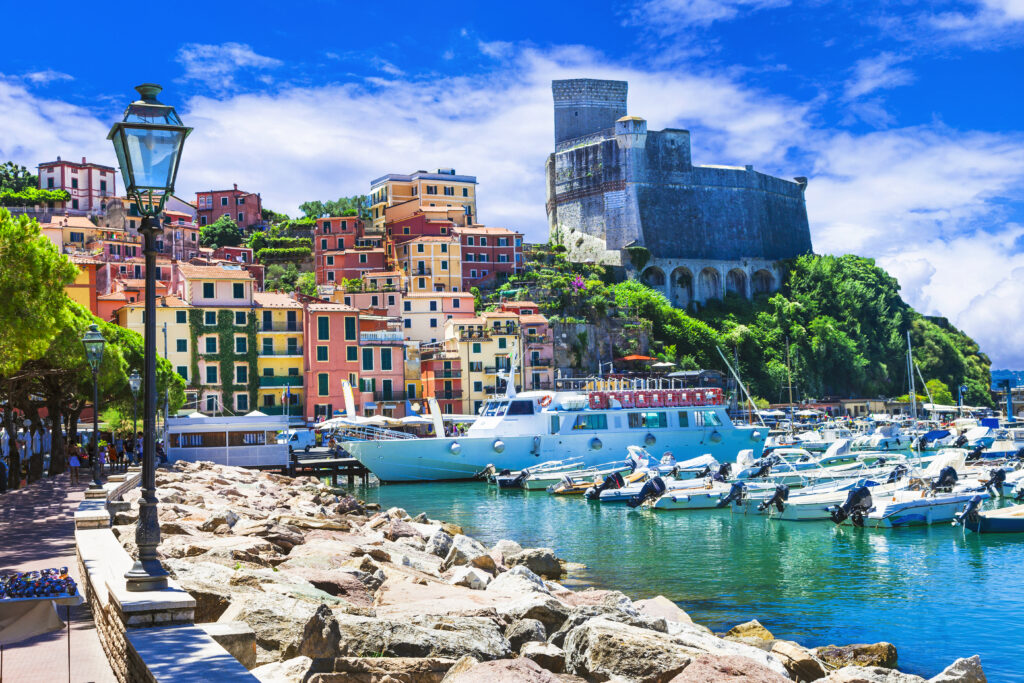
Lerici is a tranquil little coastal town with just over 10,000 inhabitants. Located at the easternmost end of the Riviera on the Ligurian Sea, Lerici is more or less the eastern end of the Gulf of La Specia. Throughout history, various great powers have fought over little Lerici, mainly because of its strategic location for military and trade purposes. Today, the coastal town is a magnet for tourists, which leads to the fact that in the summer months the number of tourists that can be found in Lerici sometimes far exceeds the number of inhabitants.
At the same time, in addition to the beautiful villa buildings from the 17th and 18th centuries, of which you can find entire districts here, Lerici offers a lot of opportunities to spend your vacation. Regardless of whether you are a nature lover or a lover of history, the Pearl of the Gulf of Poets, as the town is sometimes called, has something for everyone.
In Lerici there is not a corner that does not have some historical testimony to offer. Greeks, Romans, Genoese and Pisans, they all left their mark here. Whether in the castle of Lerici, an imposing fortress that today houses a paleontological museum, in the various historic town villas or in the Roman shipwreck that can be found just a few kilometers south of Lerici. If you go in search of traces here, you will certainly find a lot of interesting things to discover.
Bussana Vecchia
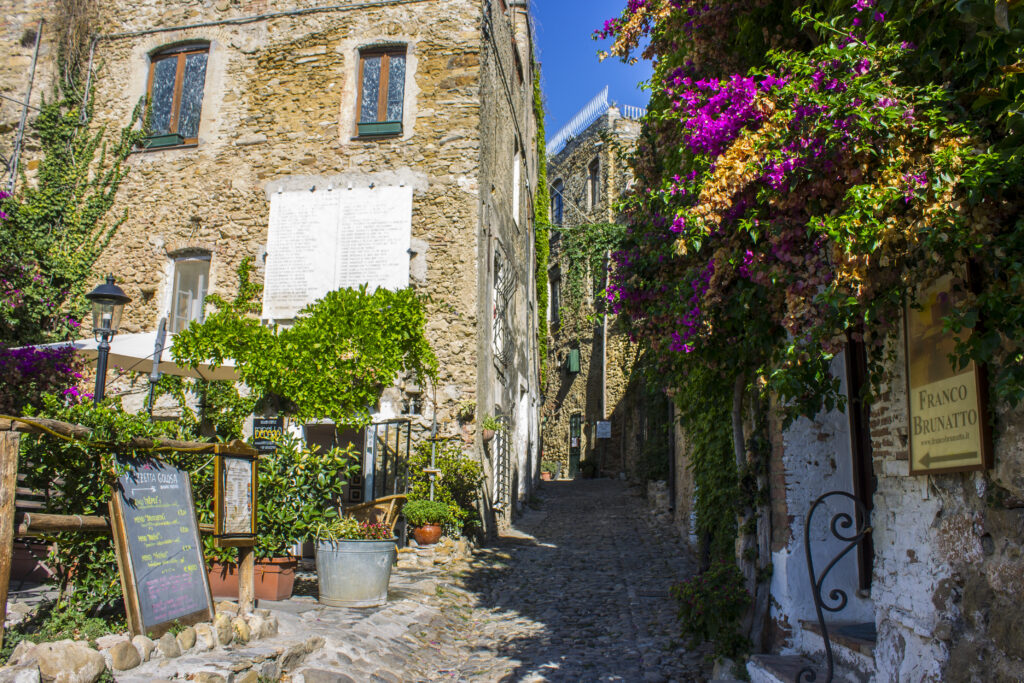
In Liguria, in the province of Imperia, there is a place that is as curious as it is fascinating for the visitor: the present-day artists’ colony of Bussana Vecchia looks back on a most bizarre history.
The beginnings of the village date back to Roman times. Over the centuries Bussana Vecchia was fortified against attacks by the Longobards and Saracens, and in the 12th century a castle complex was built here.
Then, in 1887, fate struck mercilessly: an earthquake shook the entire area. 2,000 people were killed and the old Bussana was almost completely destroyed. Down the valley, the survivors built a new settlement, Bussana Nuova, today a district of the municipality of Sanremo.
After the Second World War, the heavily destroyed buildings of the ghost town were used illegally as makeshift housing, mainly by migrant workers, but were then cleared by the authorities.
After the workers came the artists who, starting in the 1960s, established a colony in the old Bussana. In the 1970s, they were joined by hippies and dropouts from all over Europe, who provisionally rebuilt some of the dilapidated houses and set up utilities on their own.
The artists proved to be much more stubborn than the migrant workers at the time. Repeatedly, they successfully resisted the half-hearted eviction attempts and deconstruction orders of the authorities. Some still live in Bussana Vecchia today and run artisan studios, stores and small restaurants.
Camogli
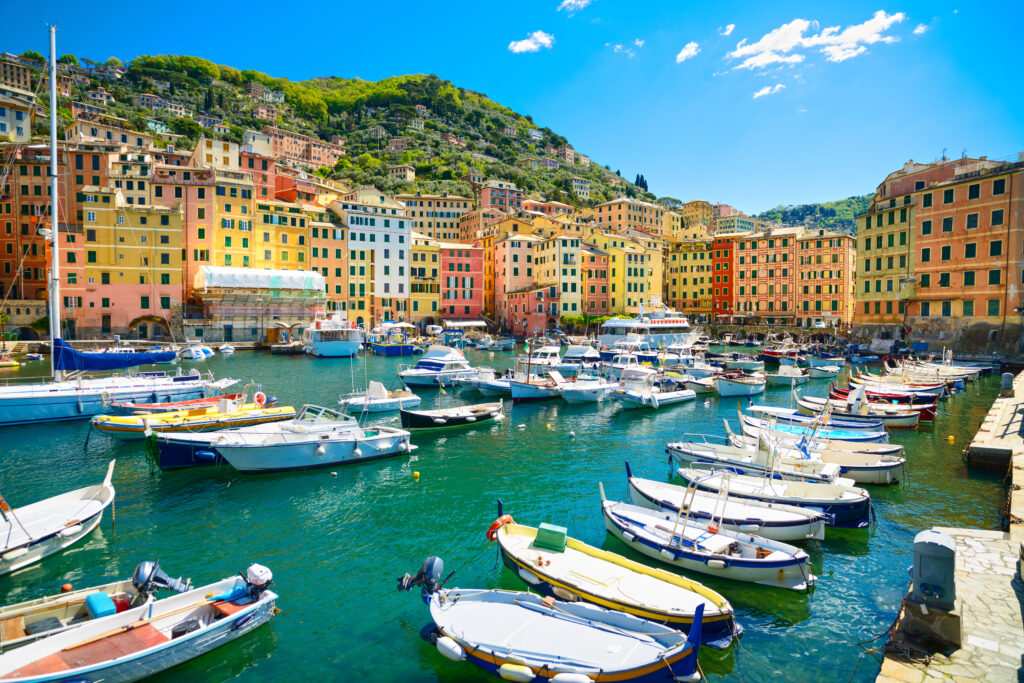
The Riviera di Levante in Liguria attracts millions of visitors every year because of the famous Cinque Terre. But there are also many other treasures along the beautiful coastline that are worth a visit. Like the harbor town of Camogli.
Located about 25 kilometers east of Genoa on the Golfo Paradiso, the fishing village – just like the nearby Cinque Terre – enchants with its colorful house facades against the backdrop of the blue sea. A special gem is the small harbor. Here you can stroll leisurely along or stop in one of the nice pubs and restaurants.
Near the harbor is the 12th century Basilica of Santa Maria Assunta, with its striking facade. Also worth seeing is the Sanctuary of Nostra Signora del Boschetto. Camogli can also boast impressive secular buildings such as the medieval fortress Castello della Dragonara.
In the Middle Ages, Camogli was particularly famous for the white sailing ships that anchored here in considerable numbers. The local maritime museum keeps the town’s maritime tradition alive. In the past, the population lived mainly from fishing. Today, tourism has replaced it as the main source of income. However, the annual fish festival held in May still celebrates and honors Camogli’s fishermen.
Albenga
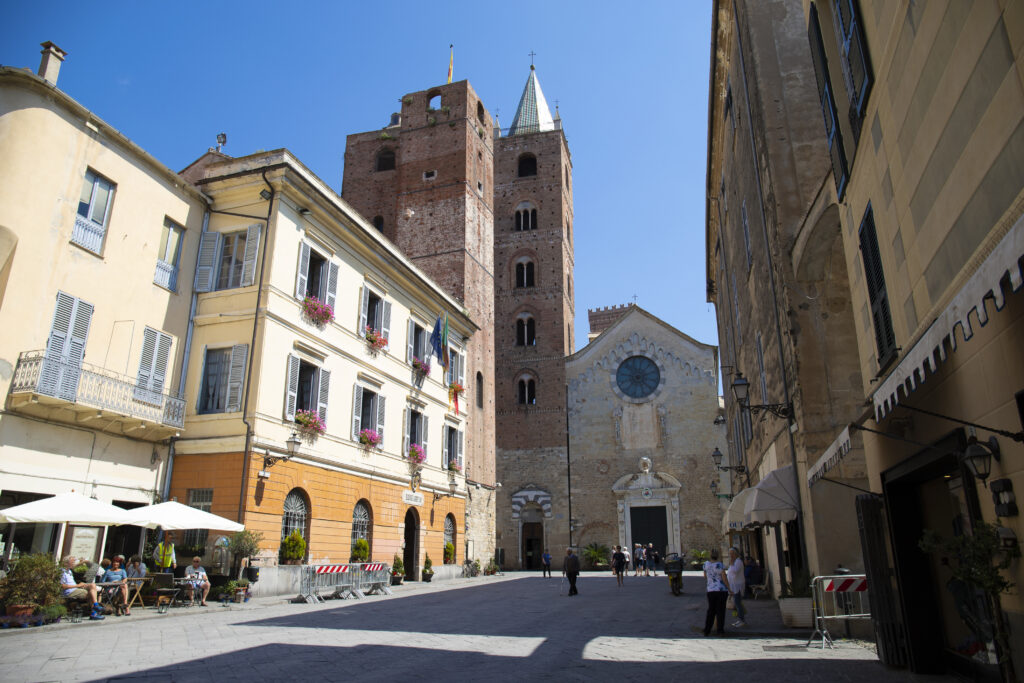
The red towers tower high above one of the most beautiful old towns in Liguria. Anyone who enters the narrow maze of alleys enclosed by a protective wall quickly succumbs to the fascination of this place steeped in history.
And around every corner a discovery awaits: bright red peppers hung out of the window to dry, ancient stone reliefs on venerable house walls, idyllic walls, idyllic views of backyards and towers.
Unique in the region is the number of slender gender towers. Over ten of these medieval towers, which the wealthiest families had built for prestige and were not afraid to compete with the church towers of the city, form the distinctive the city’s church towers, form the distinctive silhouette of Albenga. The tallest, over 60 meters is the Torre del Comune, built around 1300 for a noble family.
Right next to it rise the Torre del Municipio and the church steeple of the Cattedrale San Michele. Here at Piazza San Michele, in the heart of the old town, the most striking buildings of the city stand photogenically together in a very small space. Perhaps the most important building in Albenga ducks almost inconspicuously next to the Cathedral: the late antique Baptistery.
Also the Museo navale romano and Civico Museo Ingauno are located in Piazza San Michele. Piazza San Michele, from which the lively shopping street Via d’Aste leads to the wide Largo Doria near Piazza del Popolo. Around this picturesque core of the Centro storico extends a manageable labyrinth of narrow alleyways.
Boccadasse
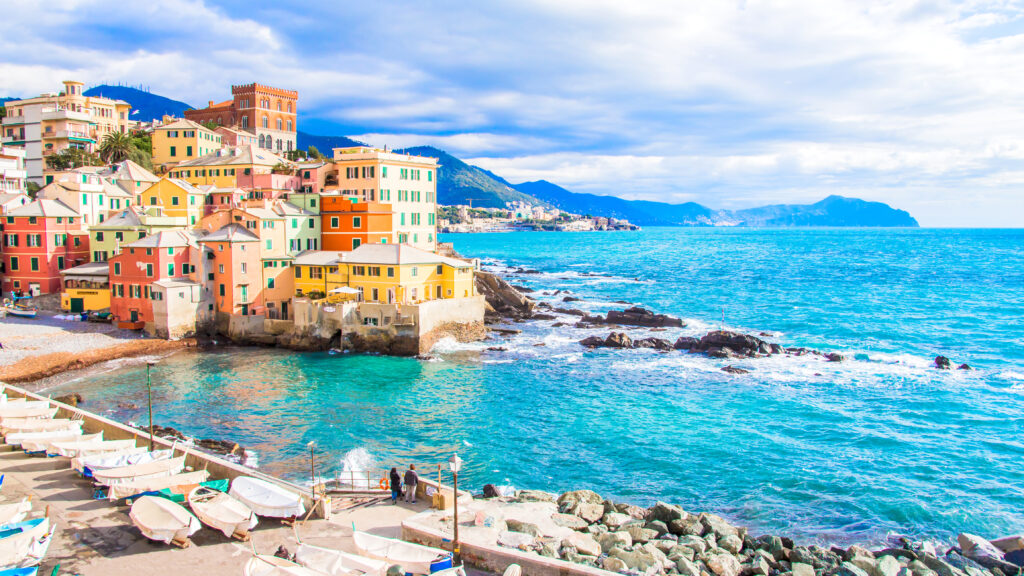
Narrow alleys, steep staircases, nested houses with Bordeaux and sandstone-colored facades, terracotta tubs of lush oleander, stone arches, tiny passageways between houses – a movie set? No, this is Boccadasse, a picturesque, dreamy part of Genoa.
On the pebble beach of the bay lie the boats of fishermen, who still go out to fish in the open sea as they did hundreds of years ago. Here, time has stood still. A place without hustle and bustle and annoying street noise. The silence is interrupted only by the sound of the sea, the waves thundering against the cliffs and the screeching of the seagulls.
Formerly an autonomous fishing village, it is a district of Genoa situated along a bay and between rocks. Spanish fishermen are the founders of this charming village. A storm forced them to dock – they stayed, founded the port and built the first houses.
Only a few fishermen still live from fishing alone. The main source of income is now tourism. Small art galleries sell their works of art. Restaurants serve regional dishes, such as piadina with tomatoes, capers and sardines or freshly caught fish. The famous ice cream of the Antica Gelateria Amadeo is a must.
Apricale
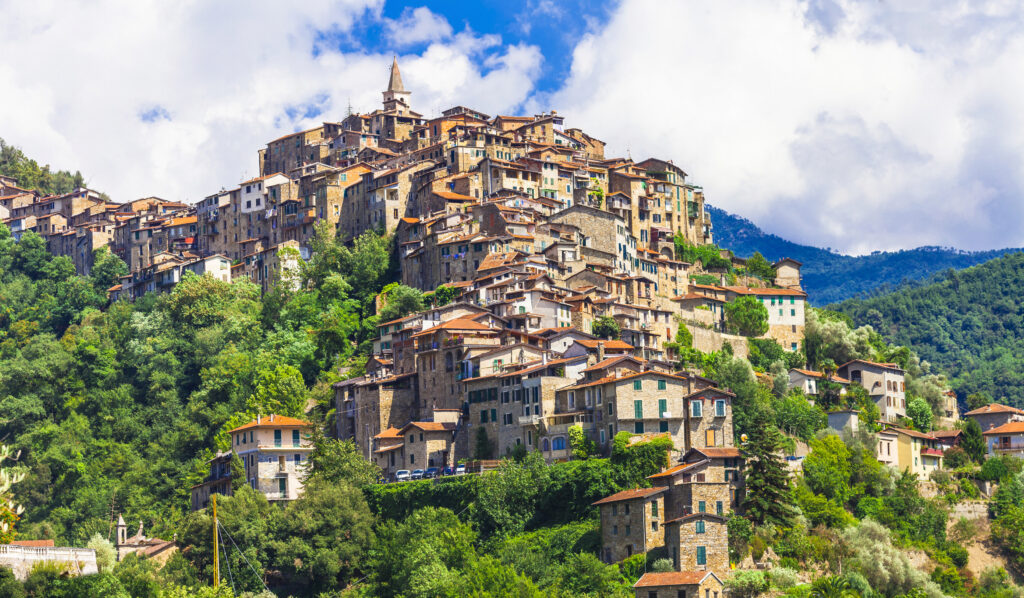
Tourists who think of Liguria usually imagine only a narrow coastal strip with many seaside resorts, stretching from Ventimiglia in the west to La Spezia in the east. Little known but no less attractive, however, is the extremely sparsely populated hinterland of this Italian region, which offers numerous untouched, wild landscapes with picturesque villages.
This Ligurian village, which from a distance looks like a waterfall of stones, is indeed tiny: Apricale has less than 600 inhabitants and is located in the Merdanzo Valley, a tributary valley of the Nervia River. If you look at the village towards the north, you can see Mount Bignone, 1299 meters high, in the background. From Apricale to the south, about 300 meters further up, you can see the eagle’s nest village of Perinaldo.
The small village is a continuous alternation of steep alleys, stairs and steps, covered passages and stone arcades. The numerous murals that can be seen throughout the village are the work of various artists on the occasion of the “Giornata dell’Affresco”, a fresco painting event that was held annually until the mid-1980s.
Around the central square, Piazza Vittorio Emanuele II, are the Oratory of San Bartolomeo, with a beautiful Baroque façade surmounted by a bell tower; further up, the parish church of Purificazione di Maria Vergine and the feudal castle (now called Castello della Lucertola).Since 2000, the church tower has been given a distinctive look by a bicycle mounted on its roof.
Finalborgo
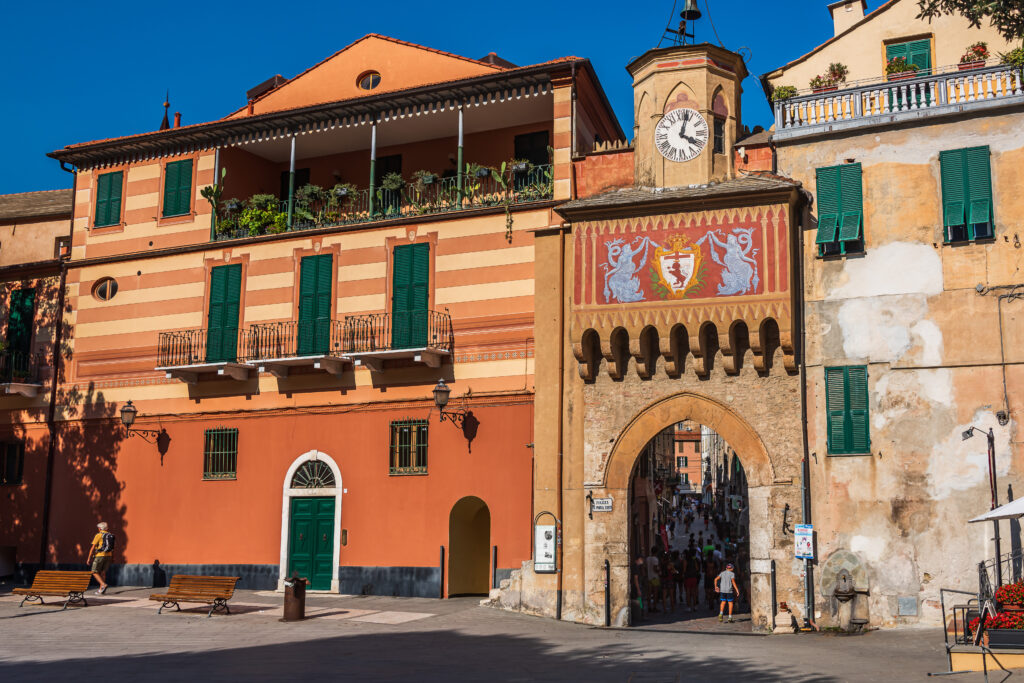
Finalborgo is the counterpart of Final Marina on the coast and one of the two districts of Finale Ligure. The fortified town is situated in a narrow valley. The old town of Borgo is still almost completely surrounded by fortified walls and towers. There are four town gates, the Porta Reale, the Porta Romana, the Porta Testa and the Porta Mezzaluna. The whole ensemble leads to a fascinating late medieval world.
Within the city walls, a city of fascinating alleys, flanked by partially painted facades and ornate portals, prepares itself. It is a narrow network of alleys that has its center in Piazza Garibaldi. Above it towers the Castell San Giovanni, which is integrated into the protection of the surrounding city walls.
Also worth seeing is the Basilica of San Piaggio at Porta Reale with its late Gothic bell tower. The church is furnished with precious sacred objects and noble furnishings, such as a magnificent 17th-century marble pulpit. The interior of the church itself is largely baroque. The Convent of Santa Catherine is a monastery not far from Porta Testa and was built in the mid-14th century. The monastery was in the branches of the Dominican Order in Liguria. In a wing of the monastery is also the archaeological museum, which can be reached through the inner cloister.
Dolceacqua
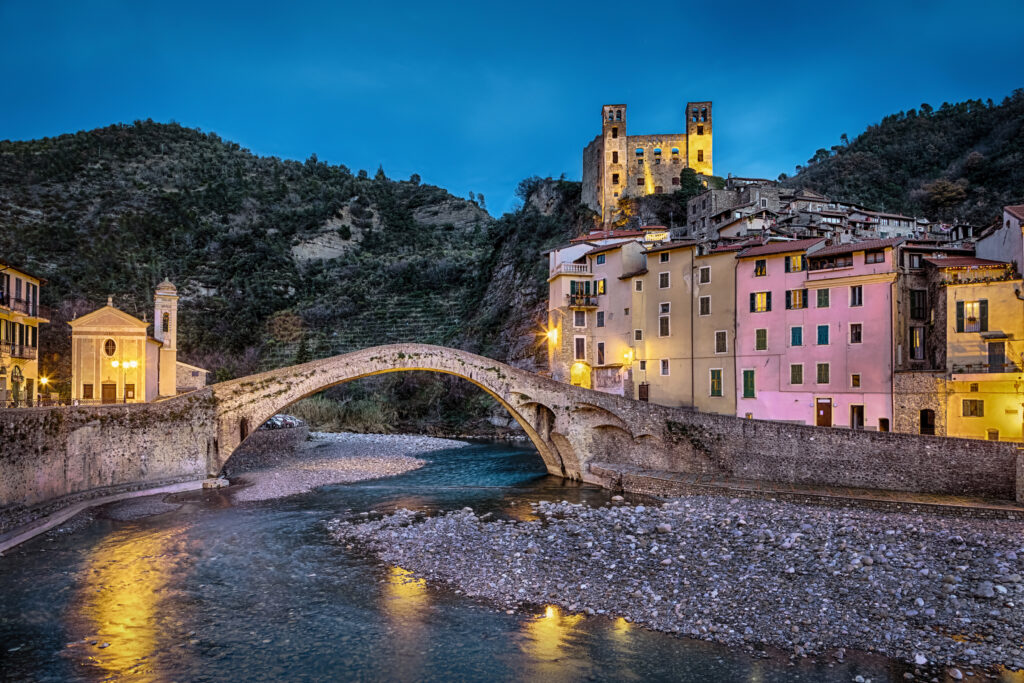
The origin of the name Dolceacqua can probably be traced back to the remains of a castle from Roman times, which belonged to a certain Dulcius. From Dulciàca and Dulcisaqua the name changed to the present Dolceacqua, which literally means “sweet water”.
The village center below the castle (the Terra district) stands out for the rustic charm of its architecture. Narrow alleys inaccessible to cars (the so-called “caruggi”) lead up the steep mountain hill.
These labyrinthine, picturesque alleys with their supporting arches and covered passages, stairways and small squares are flanked by stone houses (sometimes up to four stories high) and hide little corners of incomparable charm.
This construction, on the one hand, protected from the sun, but above all, gave the place fortress characteristics that made it easier to defend against enemies.
Besides the Doria Castle, the Nervia Bridge (the Ponte Vecchio di Dolceacqua) is the most important monument. It is an arch bridge built in the 13th century that spans the Nervia River in a single arch. The span of the arch is 32 meters. The French painter Claude Monet was inspired by the bridge to paint a picture in 1884. He called it a “jewel of lightness”.
San Fruttuoso
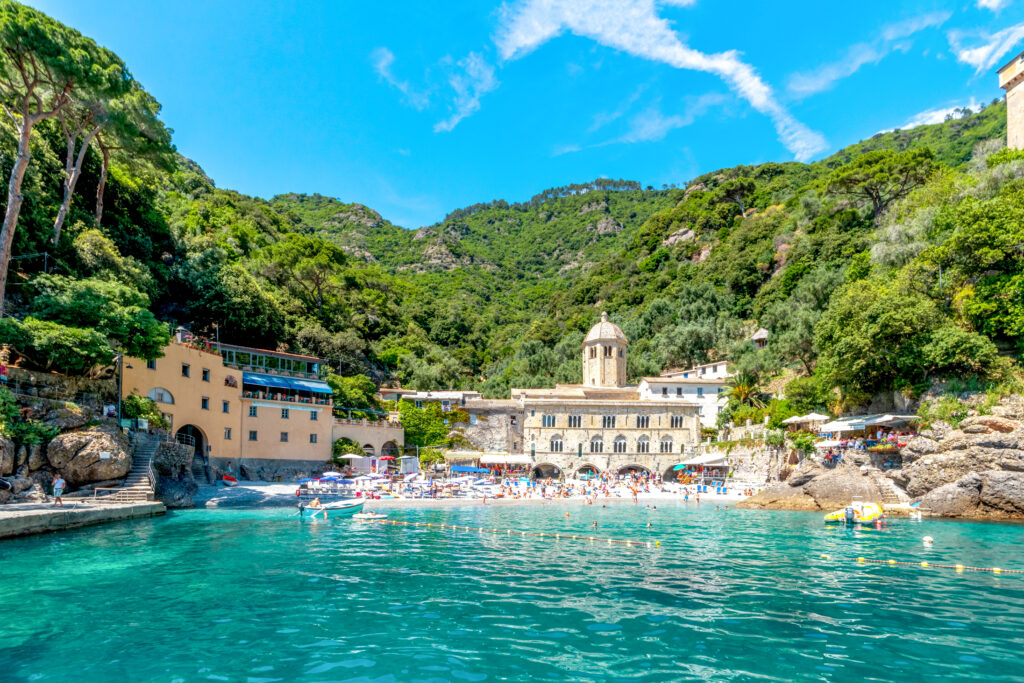
The Abbey of San Fruttuoso near Camogli is picturesquely situated in a bay on the Golfo Paradiso, between Genoa and the Cape of Portofino. There is no road connection to the solitary monastery complex dating back to the 8th century. It can only be reached by boat or by hiking trails.
The foundation of San Fruttuoso dates back to 711 A.D. It is attributed to monks who fled to the small bay from the invading Saracens. In the Middle Ages, the abbey was under the protection of the Doria family, who had a defense tower built here in the 16th century, for protection against enemy pirates. The Torre Doria, with the coat of arms of the noble family, still watches over San Fruttuoso today.
But San Fruttuoso is not only worth a visit because of the beautiful abbey. Many people come here because of another attraction – and this attraction is not located on land, but more than 15 meters below the surface of the water! We are talking about the famous Cristo degli Abissi.
The two and a half meter high bronze statue commemorates a diver who died nearby. After its completion, the extraordinary work of art was placed on the seabed in the bay of San Fruttuoso, just a few hundred meters from the monastery.
Sestri Levante
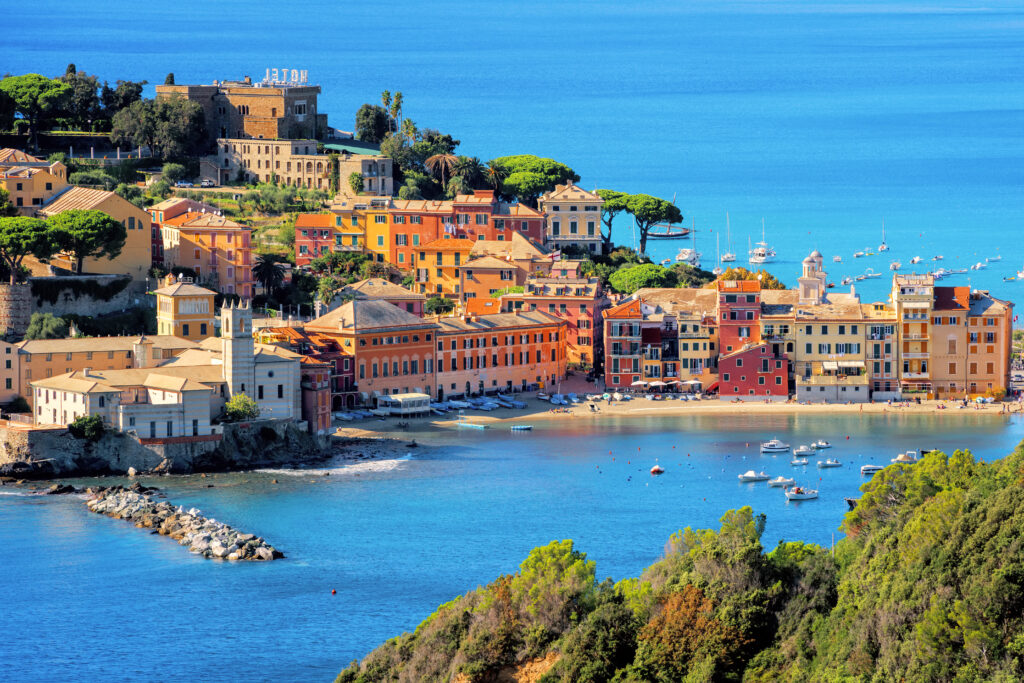
On the Riviera di Levante, not far from the popular tourist destinations of Portofino and Cinque Terre, it can still be found: The true Liguria. The coastal town of Sestri Levante enchants visitors with its special atmosphere. Colorful house facades, picturesque little streets, traditional stores and fishing boats leisurely bobbing in the water – all this can still be found here, and all this makes up the very special charm of the little town.
Due to its location on a peninsula, Sestri Levante has two beautiful bays to offer. The small Bay of Tranquility is considered one of the most beautiful in the region. Just opposite is the larger so-called Fairy Tale Bay. It was named after the writer Hans Christian Andersen, who stayed in Sestri Levante in 1833. To this day, an annual literary festival commemorates the famous author. The fairy-tale bay stretches for three kilometers; it has a beautiful seafront promenade, along which there is also a bicycle path.
The center of the old town is on the Portobello peninsula. The monastery complex (Convento dell’Annunziata) and Palazzo Negrotto Cambiaso are particularly worth seeing. Visitors to Sestri Levante should also not miss Palazzo Fascie and the town’s churches. From the mountain Monte Castello you have a beautiful view of the whole city.
Alassio
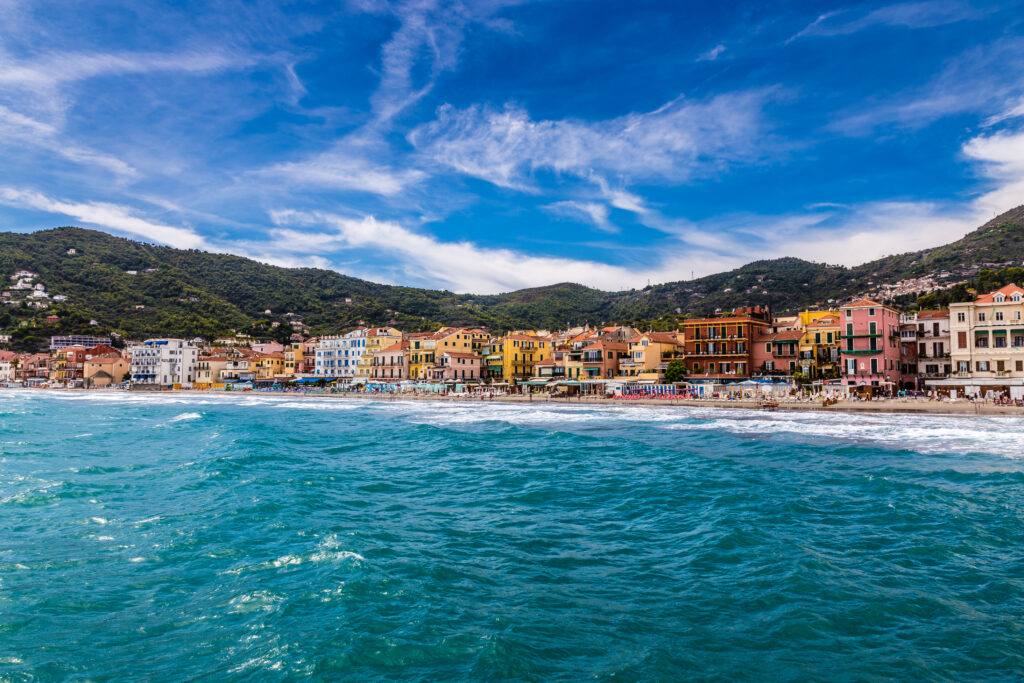
A mild climate, fine-grained sandy beaches, hills covered with vines and olive trees, and a medieval old town: the small town of Alassio on the Italian Riviera offers ideal conditions for a relaxing and interesting vacation by the sea. Many tourists are regulars and have been coming to Alassio with their families for many years.
Alassio was founded in the 10th century and was ruled by the neighboring town of Albenga until the 16th century. At the end of the 19th century the first bathers came to the small town and made sure that Alassio became one of the most popular resorts on the Riviera di Ponente. Like many other villages and towns on the Riviera, Alassio has managed to retain its original charm despite mass tourism: Those who vacation here can watch housewives shopping at the weekly market and buy fresh fish and seafood at the harbor in the morning.
Alassio has one of the few natural sandy beaches on the Riviera. In the 4 km long bay you can find over a hundred bathing establishments (lidos) where you can rent sunbeds and umbrellas. The beach, which slopes gently into the water, is particularly suitable for families with small children. In the evening, the old town with its stores, restaurants and bars invites you to stroll and linger.
Cinque Terre
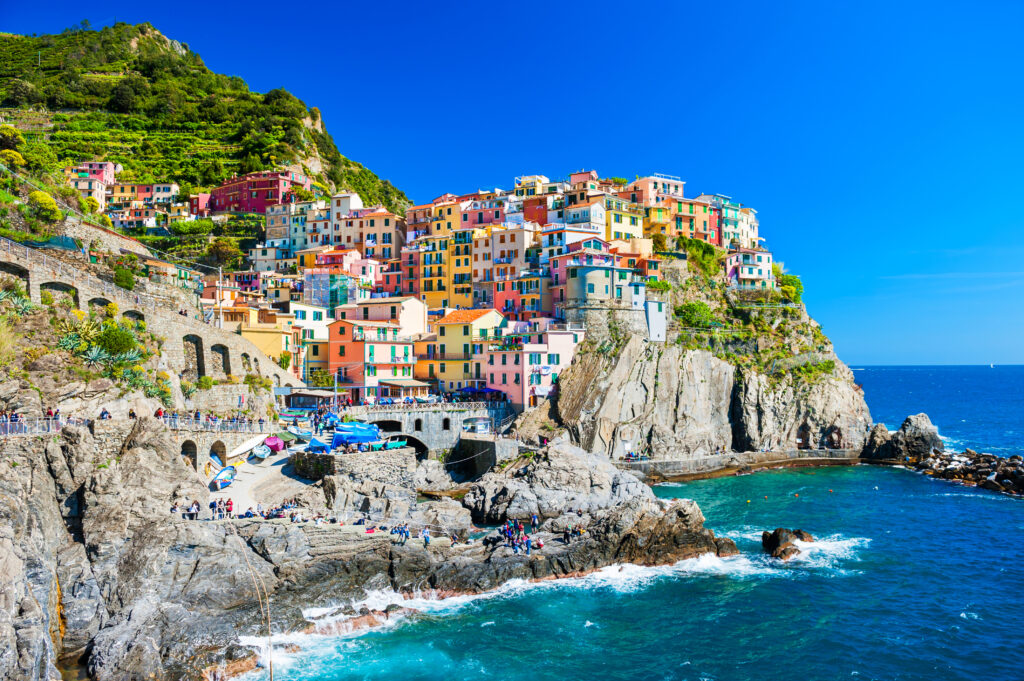
Beauty as far as the eye can see: That’s what the Cinque Terre offer nature lovers and hikers. The Cinque Terre are located northwest of La Spezia in a national park and have been a UNESCO World Heritage Site since 1997.
Monterosso, Corniglia, Manarola, Vernazza and Riomaggiore: this is the name of the Cinque Terre, which enchant visitors all year round with their pastel-colored houses, winding alleys, picturesque squares and small harbors. The five small towns lie below a lush mountain range that drops steeply into the sea along the coast, and are connected by beautiful hiking trails. With the exception of Corniglia, which is built on a 100-meter-high cliff, the Cinque Terre lie directly on the sea and have small bathing bays as well as dreamy harbors.
If you want to discover the Cinque Terre from its most beautiful side, you have to hike it. In any case, the old villages are closed to motor traffic and most of them can only be reached by very narrow and steep roads. On the other hand, the railroad connection between Genoa and La Spezia is well developed. All regional trains stop in the five villages, which makes it possible for hikers to skip a section of the journey. The network of paths in the Parco Nazionale Cinque Terre is well developed and sufficiently signposted so that even inexperienced hikers can easily find their way to the next village.
The inhabitants of the Cinque Terre have long since adapted to the influx of visitors and benefit from it. In the five villages there are beautiful hotels as well as offers for Bed & Breakfast, which welcome their guests with typical Italian cordiality. The restaurants and trattorias mainly offer delicious fish, pasta and vegetable dishes. In the Cinque Terre you should also try the dry white wine, which is grown here on the steep slopes directly above the sea.

